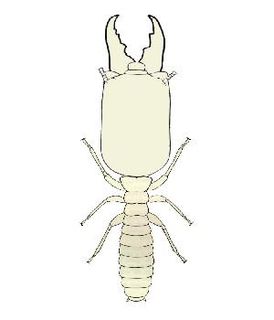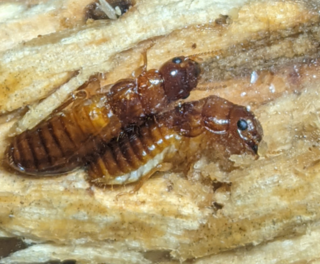Related Research Articles

Neotermes is a genus of termites in the Kalotermitidae family. The genus was first described by Nils Holmgren in 1911.
Postelectrotermes militaris is a species of drywood termite of the genus Postelectrotermes. It is native to India and Sri Lanka. It is a serious pest of tea.
Neotermes greeni, is a species of drywood termite of the genus Neotermes. It is native to India and Sri Lanka. It closely resembles Postelectrotermes militaris. It is a minor pest of tea in Sri Lanka, and major pest of mango in India.
Kalotermes jepsoni, is a species of damp wood termite of the genus Kalotermes. It is native to India and Sri Lanka. It usually prefers to live in dead and decaying wood, but sometimes can be seen in live wood. It is a major pest of tea in Sri Lanka.
Glyptotermes ceylonicus, is a species of damp wood termite of the genus Glyptotermes. It is endemic to high elevations Sri Lanka. It is a pest of dead and decaying wood of Hevea, Theobroma, Ficus, and Acacia species.
The Low-country tea termite,, also known as Low country live wood termite, is a species of damp wood termite of the genus Glyptotermes. It is endemic to high elevations Sri Lanka. It is a major pest of tea in low country area of Sri Lanka.
Bifiditermes pintoi, is a species of damp wood termite of the genus Bifiditermes. It is found in Sri Lanka.

The West Indian drywood termite,, is a species of dry wood termite of the genus Cryptotermes. It is native to Indonesia, Java and exotic to Australia, Trinidad and Tobago and Sri Lanka. It is predominantly a house termite found in natural and man-made wooden structures. Thus, this is the most commonest and most devastating drywood pest termite found in the world. It is a larger termite species, with 4.55–7.15 millimetres length in soldiers.
Coptotermes gaurii, is a species of subterranean termite of the genus Coptotermes. It is native to South India and Sri Lanka. It is a serious pest of tea in Sri Lanka.
Heterotermes ceylonicus is a species of subterranean termite of the family Rhinotermitidae. It is native to India and Sri Lanka. It is a wood destroying termites, which damage to logs, wooden structures of both natural and man-made such as tree stumps of Gravellia and Hevea brasiliensis, and tea plantations. It can be also found in mounds of Hypotermes obscuriceps.
Termitogeton umbilicatus, is a species of subterranean termite of the genus Termitogeton. It is endemic to Sri Lanka and can be seen in forests, plains, hills and human vegetation of higher elevations.
Odontotermes globicola is a species of small termite of the genus Odontotermes. It is native to India, Malaysia and Sri Lanka. It is found under flower pots and decaying logs. They construct small chambered nest with spherical combed termitaria.

Odontotermes horni, is a species of termite of the genus Odontotermes. It is native to India and Sri Lanka. It attacks many dead, decaying trees and fertilized soil. Though nests on ground, they do not construct a termitaria. It is a pest of tea, coconut and sugarcane.
Hypotermes obscuriceps, is a species of termite of the genus Hypotermes. It is native to India, Sri Lanka and Vietnam. It constructs a termitaria and is a pest of tea.
The Snouted harvester termite,, is a species of mound building termite of the genus Trinervitermes. It is native to India and Sri Lanka. Type species was described from Bandarawela area of Sri Lanka. It is a pest of sugarcane, and brinjal.

Termitomyces eurhizus species of agaric fungus in the family Lyophyllaceae native to Pakistan, India, Sri Lanka, Burma, southwestern China and Malaysia. The fungus has a symbiotic relationship with termites, its mushrooms growing out of mounds after periods of rainfall. It is eaten in Malaysia and the Indian subcontinent.
Neotermes castaneus, known generally as the southern damp-wood termite or Florida dampwood termite, is a species of termite in the family Kalotermitidae. It is found in the Caribbean Sea, Central America, North America, and South America.

Neotermes jouteli is a species of neotropical dampwood termite in the family Kalotermitidae which is native to South Florida and surrounding Caribbean nations. N. jouteli is the largest species of termite in Florida with soldiers reaching a maximum length of 13.35 mm and the winged alates around 16.05 mm.
References
- ↑ "An annotated checklist of termites (Isoptera) from Sri Lanka". National Science Foundation. Retrieved 14 February 2017.